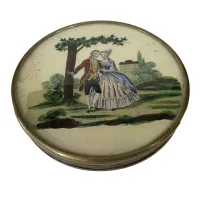Puff pastry box with decoration on the lid, 19th century
Extraordinary antique furniture and accessories
SKU: ANT-A1050t
See other products from category Antique caskets and boxes or from manufacturer Antyki with shipping within 24 hours
Description
Luxury antique furniture and accessories can be an excellent idea for decorating our interiors. Today, there are more and more enthusiasts of high-quality old products that have a specific character and soul. This is a nod to the history, creation, and design of classic and timeless furniture. There are many different styles in antique furniture, each with its distinctive features.
There are many different styles characterizing antique furniture, but we can highlight a few of the most important ones. Eclectic furniture belongs to the 19th century, which saw the reign of the Biedermeier style. Its variations in the early years of this century include Neo-Gothic, Gothic, Rococo, Louis Philippe style, and finally, the English Victorian style. By the end of the century, these styles transitioned into pseudo-classicism, Renaissance, and Baroque styles.
Empire style furniture spans the period between the late 18th and early 19th centuries. It originated during Napoleon's reign, where significant similarities and references to Roman and Greek decorations were imposed.
Classicist furniture refers to the Louis XVI style, which also strongly references ancient architecture. Interesting and noteworthy are all antique products in the Rococo and Louis XV styles. Next is Baroque, whose name comes from the Portuguese 'barocco'—meaning an irregularly developed pearl. These were very representative pieces meant to literally ooze glamour and play a significant role in luxury. Exceptional, selectively used materials were employed to further emphasize the grand tone of these products.
Today, we can observe how much influence the Baroque style has had on today's classic furniture, which is designed with great similarity to the past era. Another significant style is the Renaissance, which flourished in the 15th and 16th centuries and also left a significant mark on the art of furniture making. The Renaissance style was quite heavy and massive. Brown stains were used, as well as cornices, strong plinths, and bas-reliefs. It can certainly be said that these were quite specific products, but they offered many new possibilities, such as the construction of the sideboard or generally broadly defined chest furniture. Here, too, there was an interest in mythology and ancient times, so supports or legs took on animal forms.
Lion's paws, eagle's heads—these are common sights in the Renaissance style. Currently, many global brands recreate such furniture, taking examples from Italian or French creators. This is an expression of admiration and care for the history of the most beautiful Renaissance antiques. It should be remembered that in each country, furniture making was perceived differently, so each style in a given country had its own distinct character. This is very important, especially when searching for the right exclusive antique for your interior.
The most important aspect of original antique furniture is authenticity. This is ultimately crucial from the buyer's perspective, as there are many counterfeits on the market. Luxury Products provides a document confirming the product's compliance with the actual description and photo. At your disposal, we have art appraisers, historians, and experts from around the world.
Attributes / Details
| SKU | ANT-A1050t |
| Manufacturer | Antyki |
| Model | A1050t |
| Size | Height: 2.2 cm. Diameter: 14 cm |
| Wiek | XIX |
| Rok | 1800 |
| Gwarancja | 24 months |
| Additional information | A puff pastry box from the early 19th century with a decoration on the lid depicting a couple in love in a rural landscape with architecture in the background. Elegant. The box is made entirely of cardboard with two brass rings on the ends and printed and gold-plated cardboard ribbons on the edges. The decoration is a sous verre fixé or watercolor fixed under glass. France, first decades of the 19th century, preserved in good condition with minimal loss of color on the background |
See catalog
Reviews
No reviews for this product.














